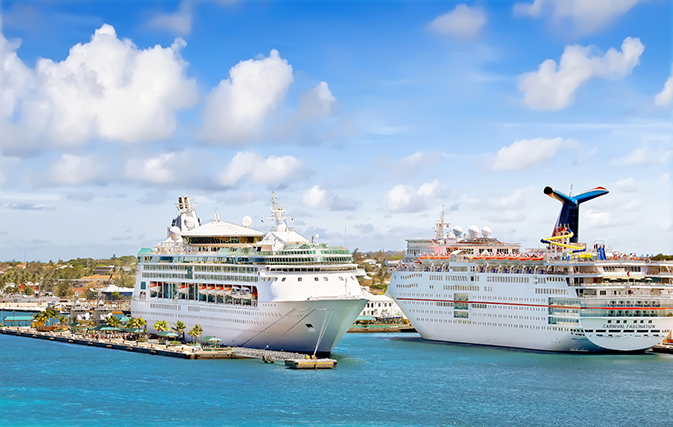This story originally ran in the Oct. 4, 2018 issue of Travelweek magazine. To get Travelweek delivered to your agency for free, subscribe here.
TORONTO — Cruise companies have finally realized that it’s just as important, if not more so, to keep your travel agent partners onside as it is to build up and market your own call centre and direct booking channels.
The relationship hasn’t been without its ups and downs but for the most part cruise lines have been a steadfast partner for the trade.
It’s at the point where cruise bookings are such a core product for so many agencies that success (or lack of it) for the cruise industry can make or break travel agencies heavily invested in cruise sales.
When cruise companies falter, travel agents feel it.
While cruise fares have dipped slightly for the world’s biggest cruise company, Carnival Corporation & plc President and CEO Arnold Donald says there’s no cause for concern.
Carnival Corp. recently posted its highest-ever quarterly performance, and that’s saying something, considering the cruise giant has been on a tear for the past few years with increasingly strong results.
With 10 cruise line brands, and 11.5 million passengers a year – that’s half the entire global cruise market – Carnival Corp. and its ships cut a sizeable wake. Cruise lines including Carnival Corp., especially with its core brand Carnival Cruise Line, have been working hard in recent years to maintain price integrity and keep yields up, and to make bargain-basement cruise fares a thing of the past.
Starting in June Carnival Corporation’s booking volumes for the first half of 2019 were running significantly higher than the prior year, at lower prices.
But more recently, during the first half of September, booking volumes for the first half of next year were still running higher than last year and at higher prices too.
Based on these booking trends, Carnival Corp. says it expects continued improvement when it comes to net revenue yields for the first half of 2019.
Gross revenue yields were up 4% in Q3. Net income for the company clocked in at US$1.7 billion, up from $1.3 billion. Revenues for the third quarter of 2018 were $5.8 billion, up from $5.5 billion.
High fuel costs are an ongoing concern and Carnival, like every other company keeping an eye on fuel prices, has warned that climbing costs will put a dent in its Q4 results. Carnival Corp.’s Q3 2018 fuel bill was $434 million, up from $307 million in Q3 2017.
For now at least, strong execution is overcoming fuel (and currency) headwinds, says Donald.
Carnival and other cruise companies have been known to levy fuel surcharges, but so far haven’t resorted to this unpopular measure despite escalating fuel bills.
Royal Caribbean Chairman and CEO Richard Fain acknowledges that rising fuel costs are a concern for Royal Caribbean too – RCCL hedges about 50% of its fuel needs. While keeping an eye on fuel costs, RCCL, parent company of Royal Caribbean, is going full steam ahead with its $1 billion investment to upgrade RCI ships, transform private island CocoCay in the Bahamas and attract more Millennials.
Just like Carnival Corp., Royal Caribbean Cruise Lines is raking in the dollars, with revenues of US$2.3 billion for Q2.
In an interview with CNBC, Fain said new ships like Royal Caribbean’s Symphony of the Seas, heading into its first full year of sailing in 2019, and the much anticipated and soon to be launched Celebrity Edge with its cantilevered floating platform, have created a lot of good momentum “and that’s carrying us nicely into 2019.”
“We’re constantly improving our ships. New features attract more customers, they pay more, and that gives us the money to build and enhance our ships,” says Fain.
RCCL, already with several brands under its belt including Royal Caribbean International, Celebrity Cruises and Azamara, is now even bigger with its majority stake purchase of luxury line Silversea Cruises this summer, with three new ships on the way.
Meanwhile Carnival Corp.’s capacity increases come with concerns about too many berths driving down prices and yields but Donald says there’s no cause for alarm.
Carnival Corp. is spreading its capacity growth over a number of its brands and geographical regions “and we’re careful when and where we add capacity,” says Donald. Any over-concentration of capacity in individual markets will be temporary, he adds, and alleviated by new demand from the undersaturated cruise market.
He adds: “We’re working aggressively to grow demand for our brands which will allow us to continue to fill our ships at increasingly attractive rates, while still providing a better value to the equivalent land-based alternative.”
And while he first attributes Carnival Corp.’s performance to the Carnival Corp. team, he doesn’t forget the cruise company’s other, equally important team: travel agents. The record-breaking Q3 results, he says, “are a testament to the tens of thousands of travel professionals who so enthusiastically support our brand.”

